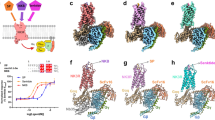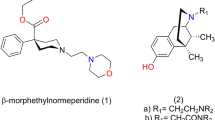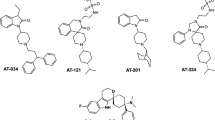Abstract
It is generally accepted that there are three subtypes of opiate receptor: µ, δ and κ. The main endogenous ligands for the µ-and δ-sites are Met5-enkephalin, Leu5-enkephalin and β-endorphin, whereas the putative endogenous ligands for the κ-binding site were unknown until recent observations suggested that dynorphin1–13 might be a candidate. The most convincing evidence for this view has been presented by Goldstein and his colleagues who showed that dynorphin1–13 is a specific endogenous ligand for the κ-receptor and has a high potency and long duration of action1–13. We show here that the sequences Leu5-enkephalyl-Arg-Arg-Ile (dynorphin1–8) and, particularly, Leu5-enkephalyl-Arg-Arg-Ile-Arg (dynorphin1–9) are selective ligands for the κ-binding site. Whereas dynorphin1–13 and dynorphin1–17 are relatively resistant to the action of peptidase and have a long duration of action in vitro after wash-out, dynorphin1–8 and dynorphin1–9 are readily degraded by peptidases and their duration of action is much shorter. For this and other reasons, the possibility will have to be considered that dynorphin1–8 or dynorphin1–9 may be transmitters or modulators at the κ-binding site while dynorphin1–13 and dynorphin1–17 may act hormonally, that is, at a distance from the site of release.
This is a preview of subscription content, access via your institution
Access options
Subscribe to this journal
Receive 51 print issues and online access
$199.00 per year
only $3.90 per issue
Buy this article
- Purchase on Springer Link
- Instant access to full article PDF
Prices may be subject to local taxes which are calculated during checkout
Similar content being viewed by others
References
Chavkin, C. & Goldstein, A. Nature 291, 591–593 (1981).
Chavkin, C. & Goldstein, A. Proc. nam. Acad. Sci. U.S.A. 78, 6543–6547 (1981).
Chavkin, C., James, I. F. & Goldstein, A. Science 215, 413–415 (1982).
Lord, J. A. H., Waterfield, A. A., Hughes, J. & Kosterlitz, H. W. Nature 267, 495–499 (1977).
Gillan, M. G. C., Kosterlitz, H. W. & Magnan, J. Br. J. Pharmac. 72, 13–15 (1981).
Oka, T. et al. Eur. J. Pharmac. 73, 235–236 (1980).
Oka, T. et al. Eur. J. Pharmac. 77, 137–141 (1982).
Magnan, J., Paterson, S. J., Tavani, A. & Kosterlitz, H. W. Naunyn-Schmiedebergs Archs Pharmac. 319, 197–205 (1982).
Römer, D. et al. Life Sci. 27, 971–978 (1980).
Minamino, N., Kangawa, K., Fukuda, A. & Matsuo, H. Biochem. biophys. Res. Commun. 95, 1475–1481 (1980).
Seizinger, B. R., Höllt, V. & Herz, A. Biochem. biophys. Res. Commun. 102, 197–205 (1981).
Goldstein, A., Fischli, W., Lowney, L. I., Hunkapiller, M. & Hood, L. Proc. natn. Acad. Sci. U.S.A. 78, 7219–7223 (1981).
Tachibana, S., Araki, K., Ohya, S. & Yoshida, S. Nature 295, 339–340 (1982).
Minamino, N., Kangawa, K., Chino, N., Sakakibara, S. & Matsuo, H. Biochem. biophys. Res. Commun. 99, 864–870 (1981).
Kangawa, K., Minamino, N., Chino, N., Sakakibara, S. & Matsuo, H. Biochem. biophys. Res. Commun. 99, 871–878 (1981).
Pfeiffer, A., Pasi, A., Mehraein, P. & Herz, A. Neuropeptides 2, 89–97 (1981).
Goldstein, A., Tachibana, S., Lowney, L. I., Hunkapiller, M. & Hood, L. Proc. natn. Acad. Sci. U.S.A. 76, 6666–6670 (1979).
Kosterlitz, H. W., Paterson, S. J. & Robson, L. E. Br. J. Pharmac. 73, 939–949 (1981).
Martin, W. R., Eades, C. G., Thompson, J. A., Huppler, R. E. & Gilbert, P. E. J. Pharmac. exp. Ther. 197, 517–532 (1976).
Gilbert, P. E. & Martin, W. R. J. Pharmac. exp. Ther. 198, 66–82 (1976).
Villarreal, J. E. & Seevers, M. H. Bull. Probl. Drug Dependence 34, Addendum 7, 1040–1053 (1972).
Swain, H. H. & Seevers, M. H. Bull. Probl. Drug Dependence 36, Addendum 1168–1195 (1974).
Swain, H. H. & Seevers, M. H. Bull. Probl. Drug Dependence 38, Addendum 2, 768–787 (1976).
Author information
Authors and Affiliations
Rights and permissions
About this article
Cite this article
Corbett, A., Paterson, S., McKnight, A. et al. Dynorphin1–8 and dynorphin1–9 are ligands for the κ-subtype of opiate receptor. Nature 299, 79–81 (1982). https://doi.org/10.1038/299079a0
Received:
Accepted:
Published:
Issue Date:
DOI: https://doi.org/10.1038/299079a0
This article is cited by
-
Dynorphin is Expressed Primarily by GABAergic Neurons That Contain Galanin in the Rat Dorsal Horn
Molecular Pain (2011)
-
Effects of acute ethanol on β-endorphin release in the nucleus accumbens of selectively bred lines of alcohol-preferring AA and alcohol-avoiding ANA rats
Psychopharmacology (2010)
-
κ-Opioid System Regulates the Long-Lasting Behavioral Adaptations Induced by Early-Life Exposure to Methylphenidate
Neuropsychopharmacology (2009)
-
Effects of acute ethanol on opioid peptide release in the central amygdala: an in vivo microdialysis study
Psychopharmacology (2008)
-
Dynorphin A activates bradykinin receptors to maintain neuropathic pain
Nature Neuroscience (2006)
Comments
By submitting a comment you agree to abide by our Terms and Community Guidelines. If you find something abusive or that does not comply with our terms or guidelines please flag it as inappropriate.



